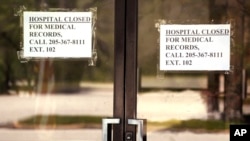Late one March morning, cell phones across Illinois activated simultaneously through the state’s emergency warning system, buzzing with the urgent text message:
“State needs licensed health care workers to sign up at IllinoisHelps.net to fight COVID-19.”
The warning came as the number of known coronavirus cases in Illinois soared, many in Chicago and the urban areas surrounding it, while the city’s sprawling McCormick Place convention center along Lake Michigan was transformed into a temporary medical facility to handle the influx of patients.
But outside Chicago, the nation’s third-largest city, among vast corn and soybean fields, smaller towns dot rural areas where concerns are growing about the relentless spread of the coronavirus, and physicians are sounding the alarm about what they need to fight it.
“I think right now, critically, it’s people … it’s the protective equipment, the masks, and it's prayers,” said Dr. Stephen Hippler. “We have an undersupply of testing kits, so we don’t always know who has coronavirus and who doesn’t, and we are facing a shortage of personal protective equipment, which really adds to the anxiety of this.”
Hippler is a chief clinical officer for OSF HealthCare, owned and operated by the Sisters of the Third Order of St. Francis, headquartered in Peoria, Illinois. OSF HealthCare serves patients in small cities and rural markets in Illinois and Michigan through 14 hospitals with a total of 2,192 acute care beds. It also operates 30 urgent care locations.
Unimaginable situation
“I don’t know how you prepare for something like this, how you envision something like this,” Hippler told VOA. “Our health care system and our hospitals all do planning for disasters, but typically it’s around tornadoes, earthquakes, hurricanes — where an area is affected, but then others can rush in from elsewhere to help. But our planning scenarios have never [imagined a situation] where the entire world is down all at once.”
Increasing the number of available working health care professionals and keeping them safe during the outbreak are among the challenges Hippler said rural health care providers face.
“I think the challenges really come in around the resources required to stand up to a pandemic like this in IT [information technology], supplies, creating negative pressure rooms, just keeping up with the clinical resources and clinical guidelines,” said Hippler. “I think it’s that infrastructure that health care is built on that rural hospitals will face a challenge with.”
“They’re really the sole source of hospital care for that community,” said Pat Schou, executive director of the Illinois Critical Access Hospital Network, or ICAHN, which connects and supports 57 rural medical facilities, many of them independent, throughout the state.
Schou, who is also president of the board of the National Rural Health Association, said U.S. Census research shows only about 15 percent of those in the United States live in rural communities, where the population is, on average, older, poorer and has a greater percentage of those with underlying health conditions at higher risk for serious illness and hospitalization if they contract the coronavirus.
“Most of these hospitals serve a rural community of around 25,000 people,” Schou said, adding that many rural patients could live a significant distance away from a health care facility.
Outpatient services are key
About 80 percent of the business that occurs at those facilities are outpatient services, such as therapy, lab services and minor surgeries.
Schou said this is the core of the business that generates revenue for many rural hospitals and is dramatically drying up as patients stay home under lockdown.
“If you only have 30 to 45 days' cash on hand, it’s going to be very, very tough,” said Schou, who believes about 25 percent of the hospitals her organization supports could suffer steep financial losses depending on the length of the COVID-19 crisis. “If this is a short-term situation, they may be fine. If it goes longer than three or four months, they are going to have severe financial strain.”
The spread of the novel coronavirus globally comes after 19 rural hospital closures in the United States in 2019. The Sheps Center for Health Services Research at the University of North Carolina said that since 2005, the country has lost 170 rural health care facilities, eight of those since January.
Schou said the loss of income and increasing financial strain could lead to difficult decisions for rural hospital administrators. “Do they keep all the staff? Do they lay off? What if they do have a surge that comes their way?” she asked, adding, “If we have a threefold surge, we’re going to have a serious problem.”
While $100 billion in financial assistance for health care providers is on the way as part of the recently enacted $2.2 trillion federal relief package, Schou said it could take weeks to filter down to rural hospitals that may need funds, support and equipment far sooner.
Competing for PPE
To make matters worse, rural hospitals are competing with larger medical systems serving urban areas for critical supplies and equipment that is in short supply.
“If you are a larger facility and you are treating these COVID patients, already you are a higher priority,” Schou told VOA.
OSF HealthCare’s Hippler said the widespread and urgent need for personal protective equipment, or PPE, continues and is complicated by the fact that much of it is supplied in China by manufacturers that suffered disruptions when the coronavirus emerged.
“It just happened that the epicenter [in China] was in the area where we get a lot of our PPE products,” he said, but PPE isn’t the only item on the growing list of needs and wants as the crisis drags on.
“We all wish we had access to more testing, more reagents, a quicker way to do that,” he said. “This is unlike flu season where it typically sweeps across the country. We’re not yet seeing a lot of that spread as intensely outside of these population centers, but we don’t know yet, it’s still early, and we’re still getting prepared.”











